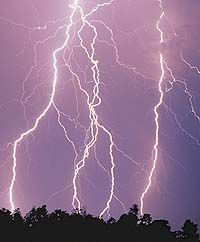| Disasters can come in many forms from weather related to man caused. In major disasters many cannot rely entirely on professional rescue operations because those services are often overwhelmed. |
In a major disaster, could you and your family be ready to evacuate in less than 15 minutes? Are you ready to survive for two weeks without assistance in a sheltering place? Would you be able and willing to assist your neighbors, friends, and/or your family? Do you have medical needs that would need to be addressed in the case of a crisis? Do you have reliable transportation? What about other means of communication (radio, cell phones, etc.)?
In the wake of Hurricane Katrina, these are questions that we all should be asking ourselves.
While Utah is not susceptible to hurricanes, we do have other disasters that we need to be prepared for. Seismologists predict that it is possible for Utah to experience earthquakes with a magnitude of 6.5. That is big enough to rock homes off their foundations.
Utah experiences earthquakes nearly every day, however, most are small and are not felt. Between September 2, and September 8 of 2005 for instance, Utah experienced 27 quakes (as found on the University of Utah website www.quake.utah.edu), and 17 of those quakes occurred in Carbon and Emery County areas. While it is not predicted that Carbon County would receive a large quake, we could still be greatly affected..
If there was a large scale quake on the Wasatch Front, it could disrupt deliveries of mail, food, and water. And that is without anticipating a large influx of people seeking shelter, food, and water. If there was a large quake in the Sevier County area, we could experience the same problems, not to mention a possible power shortage due to the disruption of some of the coal trucks which run I-70 that supply the local power plants.
It is also a possibility for Carbon County to experience the rare tornado, or there is a possibility that we could flood, especially if there were problems up river. Plus the area gets tons of hazardous materials carted through Carbon County everyday, ranging from household chemicals (such as bleach, or ammonia) to explosives.
And, as we have learned over the last couple of years as events transpired in the Red Narrows of Spanish Fork Canyon, it is possible for an accident to occur.
In some situations, it is possible that our phones won’t work, the power will fail, and even cellular phones may be of no use. In these cases can we rely on ourselves, our neighbors, and our government?
In an article published in the Washington Post in 2005, after Katrina had hit, it said “By late Sunday, as millions of people in the Gulf region sought a safe place to hunker down, hundreds of shelter beds upstate lay empty.
“We could have taken a lot more,” said Joe Becker, senior vice president for preparedness and response at the Red Cross. “The problem was transportation.”
The New Orleans plan for public buses that would take people upstate was never implemented, and while many residents did manage to get out of town — about 80 percent, the mayor said — tens of thousands did not.”
Once the hurricane hit, “communication was practically nonexistent.”
The article also stated that help did not arrive when it was expected.
“Around midnight, at the last of the day’s many conference calls, local officials ticked off their final requests for FEMA and the state. Walter Maestri specifically asked for medical units, mortuary units, ice, water, power and National Guard troops.
“We laid it all out,” he recalled. “And then we sat here for five days waiting.”
Help began to slowly trickle in, but it wasn’t enough soon enough.
“Aug. 30: ‘It’s 11 days later. . . . Where’s the cavalry?'”
While it may seem that the governments programs were inadequate to handle a crisis situation, a point needs to be made that once an evacuation or emergency is implemented, people are responsible for themselves, their children, their elderly, and their pets. If a family needs help, they need to be sure to have those details worked out before anything occurs. We should know our schools’ emergency plans, our elderly care takers emergency plans, as well as having one for ourselves.
These points are not made to frighten anyone, only to educate. Emergency preparedness personnel are working to bring education to our community and help protect our families.
Serving in our communities, working for you. The Price City Emergency Preparedness Committee hopes to see you at the fair.

